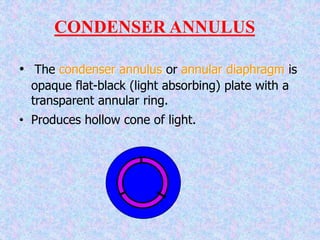The document provides an overview of microscopy including:
1. It discusses the historical development of the microscope from its invention in the 1590s to improvements made by scientists like Hooke, Huygens, and van Leeuwenhoek in the 1600s-1700s.
2. It describes several types of microscopes like brightfield, darkfield, phase contrast, fluorescence, electron (TEM and SEM), confocal, and scanning probe microscopes; and explains their basic optical principles and uses.
3. It covers various optical components and concepts in microscopy like magnification, resolution, numerical aperture, aberration, contrast, and different techniques like micrometry.







































































